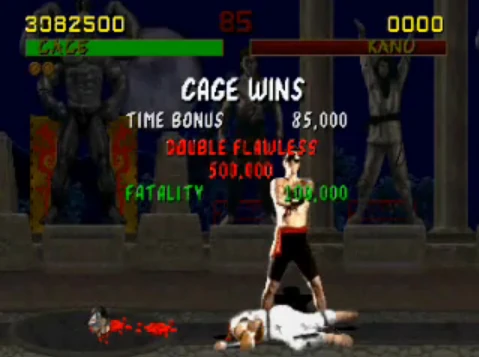mNo edit summary |
m (→Death Trap) |
||
| Line 72: | Line 72: | ||
====[[Death Trap]]==== |
====[[Death Trap]]==== |
||
| − | [[Video:All Stage Fatalities & Death Traps|thumb|250px|right|Death Traps]]''[[Mortal Kombat: Deception]]'' and [[Mortal Kombat: Armageddon|''Armageddon'']] features a modification of the traditional Stage Fatalities, the "Death Traps". |
+ | [[Video:All Stage Fatalities & Death Traps|thumb|250px|right|Death Traps]]''[[Mortal Kombat: Deception]]'' and [[Mortal Kombat: Armageddon|''Armageddon'']] features a modification of the traditional Stage Fatalities, the "Death Traps". Death Traps do not need a special button combination as the opponent only needs to be either standing or hit in a particular spot on the stage. Unlike previous Stage Fatalities, Death Traps can be initiated anytime during a round and only require the opponent be hit into them, meaning an instant victory. However, if they are not executed in the decisive round, the fight does not end, going on to the next round. This action acts as a ring out. |
===Hara-Kiri=== |
===Hara-Kiri=== |
||
Revision as of 15:05, 9 June 2014
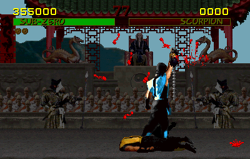
The elder Sub-Zero performing the Spine Rip Fatality in Mortal Kombat
In the Mortal Kombat series of fighting games, a Fatality is a special finishing move that can be used against one's opponent at the end of the final match. When the announcer says "Finish Him" or "Finish Her" if the opponent is female, the player can choose to kill him or her through a fatality move. If input correctly, the background will darken, followed by the desired result.
Unlike special moves, a Fatality may require certain distances and quick button sequences in order to achieve the desired result. For example, in Mortal Kombat 3, one of Sub-Zero's Fatalities requires that he stands close to the opponent and quickly execute Block, Block, Run, Block, Run. Every character has their own special Fatality that must be performed at a certain distance from the opponent. The number of Fatalities varies depending on the game; while characters in Mortal Kombat and Mortal Kombat: Deadly Alliance had only one, Mortal Kombat 3 and its updates featured as many as four.
In the movie, the word "Fatality" is actually said once by Shang Tsung.
Fatality-style finishing moves have also appeared in other fighting games from Midway (Killer Instinct, War Gods, Bio F.R.E.A.K.S., Mace: The Dark Age), and other companies (Blood Warrior, Tattoo Assassins, Way of the Warrior, Primal Rage, Samurai Shodown IV, Deadliest Warrior: The Game,), though they are not named as such usually.
The beginning
With Street Fighter II dominating arcades, Mortal Kombat co-creators Ed Boon and John Tobias wanted to create a fighting game that retained Street Fighter's gameplay without being a complete copy. Originally, the project revolved around actor Jean Claude Van Damme; this idea was eventually dropped and Mortal Kombat was born.
Tobias and Boon started with Street Fighter II's system and retained many of its conventions (fireball-style projectile attacks, one on one matches, minigames, etc.), but tweaked others (the block button, special endurance matches, juggling, etc.). The most notable additions were graphic blood and Fatality finishing moves. Traditional fighting games end with the loser knocked unconscious and the victor posing for the players; characters never died during a match. The idea of a Fatality proved very popular with fans.
Conception
While creating Mortal Kombat, Ed Boon and John Tobias started with the idea of Street Fighter II-like system and retained many of its conventions, but tweaked others. The most notable additions were graphic blood effects, more brutal fighting techniques, and especially the fatal finishing moves (this was a novelty as the traditional fighting games ended with the loser simply knocked unconscious and the victor posing for the players).
According to Boon, "it started with an idea to enable the player to hit a dizzied opponent at the end of the match with a "free hit", and that idea "quickly evolved into something nasty". According to Tobias: "Our first idea was to use them as a finishing move for the final boss, Shang Tsung, who was going to pull out his sword and behead his opponent. Then we thought, What if the player could do that to his opponent?" When we watched players react to the Fatalities, we knew we had no choice but to give them more."
Reaction
Mortal Kombat attracted numerous fans because it featured blood and the ability to perform Fatalities. The new feature addition helped make Mortal Kombat a successful game franchise that challenged the supremacy of Street Fighter II.
The Fatality concept caused considerable controversy, and many parents disapproved of the violence and the brutal endings of the game, deeming it disturbing.
The newly-founded ESRB gave Mortal Kombat a rating of M, deeming the game too violent for audiences under the age of 17. It's worth noting that, in the United States, the ESRB has no legal standing to prevent the sale of video games to minors, and therefore many people under the suggested age were able to play the game. Arcade owners were asked to monitor the ages of players, although few did.
Mortal Kombat II added some extras when it came to Fatalities. The characters were given two Fatalities each, and the Fatalities were more violent. Many angry parents and protesters wrote letters and complained about the content of the game, but since the ESRB had already rated the games, nothing came of the protests.
Many parents feared that the introduction of Fatalities would influence children to murder, and to teach them that it was okay to kill their enemies at school if they were threatened or accidental murder.
Fatality Types
- Decapitation - The most recurring type. Removes the head from the body through blunt force, forcefully removed or a slicing weapon (e.g., Sub-Zero's signature 'Spine Rip').
- Immolation - Another common type. Victim suffers from severe burns from high-powered flames that often remove skin and flesh from the body, leaving behind charred bone (e.g., Scorpion's signature 'Toasty!').
- Crush - A common type of Fatality. Crushes the opponent to death either with telekinetic powers, physical force or a machine (e.g., Cyrax's 'Trash Compactor')
- Bifurcation/Vivisection - Splits the victim in half at the waist area, vertically, or in the head (e.g., Kung Lao's 'Razor's Edge').
- Explosion - Reduces the victim into a pile of gore through explosive techniques and/or devices (e.g., Stryker's 'Have a Blast').
- Impalement - Runs the opponent through, often with a sharp weapon (e.g., Jade's 'Half Mast').
- Skinning - Skins the opponent alive, either by being burned or with physical force (e.g. Sheeva's 'Stripped Down')
- Amputation - Removes appendages through forceful means. Victim dies of blood loss (e.g., Noob Saibot's 'As One').
- Gash - Creates a big wound or multiple smaller wounds on the opponent with a sharp weapon. Victim dies of blood loss (e.g., Kabal's 'It takes Guts')
- Devour - Kills opponent by eating a part or their entire body (e.g., Reptile's signature 'Tasty Meal').
- Morphing - Changes into someone else to kill the opponent in a gruesome fashion (e.g., Shang Tsung's 'Bang Bang!').
- Suicide - Kills the opponent by killing themselves in one way or another (e.g., Sub-Zero's 'Kold Fusion')
- 2 in 1 - A new version of the traditional fatality demonstrated in Mortal Kombat (2011), where most kombatants finish off the victim with a combination of two previous Fatalities (e.g., Johnny Cage's 'Heads Up!')
- Miscellaneous - Fatalities of a unique nature not shared with others (e.g., Kenshi's 'Scatterbrained').
Other Finishers
- Animality - This finisher allows the player to morph into an animal and maul or eat their opponent alive. This style of Fatality debuted in Mortal Kombat 3. Some say the precursor to the Animality was Liu Kang's Dragon Fatality from Mortal Kombat II, in which he turned into a dragon and ate the upper half of his opponent. That Fatality was turned into Liu Kang's Animality in UMK3. Also, since Sheeva turned into a scorpion for her Animality, Scorpion got a penguin transformation. Due to this, the MK crew got complaints from the fans, so the crew added, in MK4, a scorpion transformation as one of his Fatalities. In order to perform an Animality, the player must first grant his opponent Mercy, the act which revives the opponent in lieu of delivering a final blow or performing a Fatality by restoring a small amount of health: should the opponent be defeated again, an Animality may be performed.
- Brutality - Introduced in Mortal Kombat Trilogy and the SNES and Sega Genesis ports of Ultimate Mortal Kombat 3, this finisher allowed players to perform a combo which would end in a uppercut, causing the opponent to explode. Brutalities were not very popular, as they were extremely difficult to accomplish, requiring the player to memorize and perform a special 11-hit combo. Many felt the pay-off was lacking with the only result being a fiery explosion where the victim disappears and an unrealistic amount of bone and flesh are sent flying and covering most of the screen. In some versions, the bone and flesh flies completely offscreen. This finisher didn't appear in another game until Mortal Kombat: Shaolin Monks, in which it wasn't explicitly used as a finisher, but rather as a power-up.
- Weapon Fatality - In addition to Mortal Kombat: Tournament Edition one Fatality by character, there's also a new kind of (unlockable) finisher. The weapon Fatalities are basically Fatalities, but all the character does is to use his/her weapon of style to kill his/her opponent making a combo of the normal weapon moves. MK:TE is the only one to have it, since that the MK characters have Fatalities through their history that use his/her DA/TE/D/U/A weapon fighting style that are counted just as 'Fatality'; also, when one of those are performed, the announcer also says "FATALITY", in the same time that the game displays "WEAPON FATALITY".
- Multality - Mortal Kombat: Shaolin Monks also features Multalities, which are Fatalities performed on multiple enemies at one time. This was the only Mortal Kombat game to ever use this finisher.
- Heroic Brutality - In Mortal Kombat vs. DC Universe, many of the DC characters are superheroes who have sworn an oath against ever taking lives, Superman and Batman for example. Instead of performing Fatalities, they can perform Heroic Brutalities, which severely injure their opponent, but leave them alive to face justice. It should be noted, however, that villains from the DC Universe have no such oath, and perform Fatalities, not Heroic Brutalities.
- Babality - The defeated characters turns into a baby, sitting on the floor and wearing a miniature version of their adult clothing and accessories and/or a diaper (nappy) while crying. In some versions, the sound effect of a baby crying plays, along with a lullaby, and the word "Babality" is spelt out by colored building blocks that fall from the top of the screen. The announcer then declares (Albeit unusually and unnervingly gently) "Babality!!"
- Friendship - Instead of injuring or killing the loser, the victor will make a peace offering, such as Sub-Zero using his powers to make a snowman, Scorpion startling his opponent with a skull in a Jack-in-the-Box, Liu Kang dancing while the disco ball appeared in the stage, or Johnny Cage offering a signed photo of himself. The announcer is generally disappointed when a match ends in Friendship, saying "Friendship. Friendship?" or "Friendship. Friendship? Again?"
- Fergality - A finisher performed by Raiden in MKII for the Mega Drive, the defeated characters turns into Probe Ltd. employee Fergus McGovern, who worked on that port of the game.
Stage Fatalities
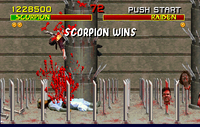
The Pit I Stage Fatality on Raiden
Stage Fatalities brought a new level of environment interaction within the series. A stage Fatality occurs when a player uses a part of the stage or map to execute a Fatality that is not a standard character Fatality. Some examples of stage Fatalities are having the victim fall into a pool of acid or a pit of razor-sharp spikes, or to be run over by a subway train. Stage Fatalities are present in the series from Mortal Kombat through Mortal Kombat Gold, Mortal Kombat: Deception's Puzzle Kombat, Mortal Kombat: Armageddon's Motor Kombat and Mortal Kombat (2011), being absent from the series in several years.
Death Trap
thumb|250px|right|Death TrapsMortal Kombat: Deception and Armageddon features a modification of the traditional Stage Fatalities, the "Death Traps". Death Traps do not need a special button combination as the opponent only needs to be either standing or hit in a particular spot on the stage. Unlike previous Stage Fatalities, Death Traps can be initiated anytime during a round and only require the opponent be hit into them, meaning an instant victory. However, if they are not executed in the decisive round, the fight does not end, going on to the next round. This action acts as a ring out.
Hara-Kiri
The new kind of "Anti-Fatality" introduced in Deception is the Hara-Kiri. The Hara-Kiri (which is a type of Japanese ritual suicide, that literally means belly cut, is practiced when some person brings shame to his/her own family) is a move in which the defeated player kills him/herself upon defeat at the end of the last match, rather than be finished off by their opponent. This still results in a win for the character who was victorious in battle, it is just seen as an incredibly stylish way to go out. It is the first and so far only time in the Mortal Kombat series in which the defeated player is allowed to perform a finishing move. Each character has a different combination that can only be performed if the input corresponds to which character is defeated. The Hara-Kiri made its debut in Deception and seems to be a popular feature with the fans, although is not included in Mortal Kombat: Armageddon due to the limited Kreate-a-Fatality feature.
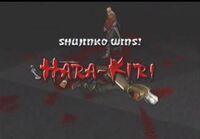
Shujinko's Hara-Kiri
Although it has been available only in Deception, in some previous MK games showed homicidal-suicidal Fatalities. The first one was Cyrax's "Self-Destruct" from Mortal Kombat 3/Ultimate/Trilogy/Gold/Advance; Cyrax, a cyborg, enters a code on to his arm panel and moments later explodes along with his opponent in a manner reminiscent of the ending of the first Predator movie. Smoke, in MK3, went farther with his Fatality since he destroys the whole planet with his bombs, including himself and his opponent. In MKG, Cyrax borrowed this Fatality from Smoke together with his own while Smoke adopted Cyrax's self-destruct as his Hara-Kiri in Deception. Raiden, in Deception, also has a Fatality in which he sends electricity to his opponent, who explodes, then it gets back at him exploding himself too. In Mortal Kombat (2011), Cyber Sub-Zero has a fatality where he jumps onto an opponent, freezes himself with them, and both explode to ice bits (though the opponent only had the bottom half of his body intact).
Kreate-A-Fatality
For Mortal Kombat: Armageddon, the Fatality concept was completely revised. In all previous games, Fatalities and finishing moves were in the form of a button combo, activating a scripted animation sequence. In Armageddon, this system was replaced with a new Kreate-A-Fatality (KAF), or "custom chain-Fatality" system. After defeating an opponent in two rounds (with default settings), players are given a limited amount of time to perform one of several violent moves (such as ripping an organ out or snapping their neck) attributed to a button and direction combination. The time then resets and the player can perform a second move, but the timebar decreases more rapidly after each move. The longer a player is able to continue the chain, the higher ranking his Fatality receives; "Killer" Fatality, "Brutal" Fatality, "Evil" Fatality, etc. It is possible, with practice, to pull off a Fatality of up to ten moves or possibly higher. It is also possible to "fail" the Fatality by running out of time before performing a final finishing move (such as ripping the opponent's head off). If time runs out before the player can end the chain with a final fatal move, no rank or reward is given and the Fatality is not counted, regardless of how many moves were completed.
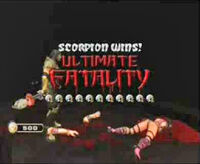
Scorpion doing the Rank Ultimate Fatality
Ranks of Kreate-a-Fatality
- Fatality (1 move)
- Deadly Fatality (2 moves)
- Killer Fatality (3 moves)
- Bloody Fatality (4 moves)
- Mortal Fatality (5 moves)
- Brutal Fatality (6 moves)
- Evil Fatality (7 moves)
- Vicious Fatality (8 moves)
- Savage Fatality (9 moves)
- Extreme Fatality (10 moves)
- Ultimate Fatality (11 moves)
This new system required that other forms of finishing moves, such as Deception's popular Hara-Kiri self-Fatalities, be left out of Armageddon. This was met with a mixed reaction, some fans preferring the more interactive nature and freedom of the Kreate-a-Fatality system, and others missing the previous games' character-specific ending moves and alternatives to killing the opponent. Also, originally, there were individual character-specific Kreate-a-Fatality moves for each character, with other characters unable to access them, but this idea was dropped somewhere along the way, and in the final product all characters' pool of moves are identical, except for Shokans (Goro, Sheeva and Kintaro) and beast characters (Moloch, Blaze, Onaga and more) with the only exception being Motaro, since he has the normal characters´ moves.
Behind the scenes
thumb|280px|rightThe Fatality concept originated from various developers' wishes to further emphasize victory at the end of a match, so much as to rub it in the loser's face, although Steve Beran himself stated in a G4 interview that he wondered if it was possible to "rip a guy's heart out". Ed Boon and his fellow staff often come together to collaborate on ideas of different Fatalities often derived from movies, especially those from Japan.
The effect of dismemberment simply came from digitally editing body parts of the actors. The charred skeleton sprite came from a small skeleton figurine, animating it via stop-animation and adding fiery effects and resizing it to match the actors' size. In the History of Fatalities, the original figurine was stated to have been destroyed from constant bending, the only remnant existing being the arm, the main part used for MKII's burning animation. The bloody effects were digitally drawn on the actors when body parts were edited off. Kung Lao's Hat Slice vivisection effect was done by capturing footage of the actor falling to one side, cutting the images in half and then mirroring it.
Film
- In the first movie Mortal Kombat, Shang Tsung consumes the soul of his opponent, leaving behind a Fighting Monk's corpse. He says: "FATALITY!"
- In Mortal Kombat: Legacy Season I, Cyrax performs a Fatality on Hydro with a forked blade from his wrist. In Season II, several Fatalities are performed by the various kombatants of the tournament: Kenshi telekinetically thrusts his sword Sento through Ermac's heart, Kitana decapitates Mileena, and Scorpion performs the classic Spine Rip Fatality on Sub-Zero.
Trivia
- The Fatality concept was listed #8 on ScrewAttack's "Top 10 OMGWTF Moments"
- In addition, Screwattack also created the list "Top 10 Mortal Kombat Fatalities". Some of them included Scorpion's Spear Shot from Deadly Alliance (Number 4, nicknamed 'Party Popper') and Quan Chi's Leg Beatdown from MK4 (Number 9).
- Screwattack also made the list "Top 10: Worst Mortal Kombat Fatalities". Some of them included Quan Chi's Neck Stretch from Deadly Alliance and Liu Kang's Flipping Uppercut from the first Mortal Kombat, as well as the censored versions of MK vs DC Fatalities.
- In addition, Screwattack also created the list "Top 10 Mortal Kombat Fatalities". Some of them included Scorpion's Spear Shot from Deadly Alliance (Number 4, nicknamed 'Party Popper') and Quan Chi's Leg Beatdown from MK4 (Number 9).
- There were rumored types of Fatalities that did not actually exist in any of the games. These included:
- Hookality
- Gangstality
- Nationality
- Nudality
- Rapality
- Sexuality
- Beastiality
- Weirdality, among others.
- Mortal Kombat (2011) offers, as new Fatalities, to several characters, a combination of two of his or her Fatalities from from the previous games, such as Cage uppercutting his opponent's head off, then throwing his/her torso on the ground, these two moves are his Fatalities from MKII.
- Also, in MK 2011, before the characters perform a Finisher, they do a "battle cry"-like position (e.g. Scorpion gets to a slide like pose and fiercely shouts; Jade plays with her staff saying "too easy"; Johnny Cage says "Watch this!"; Kratos unsheathes his Blades of Exile, even if the Finisher does not use them at all.)
- There are nine characters who have never received unique Fatalities: Chameleon, Meat, Mokap, Taven, Daegon, Khameleon, Blaze, Moloch, and Onaga.
- In MK 2011, the announcer has several different ways of saying Fatality.
- There are Fatalities that were done in the game intros, like the neck breaking in Liu Kang's death in MKDA, Raiden's 2nd Fatality, and many more.
- Johnny Cage, Sonya and Jade are the only ones who talk during the beginning of their Fatality in MK (2011).
- Liu Kang and Scorpion are the only characters to use an Animality as a Fatality.
- However, Scorpion used it only once, in MK4/MKG. Liu Kang, on the other hand, used it in most of the games he participated in.
Gallery
Videos

